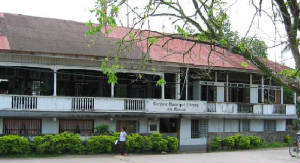| |

|
| This was be the original Municipal Building |
MUSEUMS are much an arena of popular and collective images of a people as editorial or comic magazines are. They actually
draw the resources of public culture and popular imagery and, in a sense, democratize culture and the arts.
Carigara, one of Leyte's old towns, enables tourists and residents to learn not only the Leytenhon history but also the diverse
and complex realities, which have shaped Eastern Visayan way of life.
The whole town is actually a visual display of Spanish colonial houses, American-influenced architecture, and post-World War
II artifacts.
It is likewise energized, daily, by a wealth of lore affirming at the more popular level Carigara's, if not Leyte's, contributions
to the nation's historical, cultural, political and economic development.
Consider Bangkaw's religious revolt (one of the earliest acts of defiance against foreign aggression in the country) against
Spanish colonizers, the birthplace of Leyte's reputed writers, and the meticulous preparations of Leyte's well-known delicacies
like roscas and pastillas.
Carigara opened its museum-cum-library to the public on March 31, 1997. The infrastructure itself offers lengthy historical
narratives about the town when it was the seat of the municipal government during the Spanish, American and post-World War
II colonial times.
It now houses a historical treasure which old-timers had been keeping in their households: makina de mano (hand-turned sewing
machine), prensa (flat iron), grapopono (record player), Dama Juana (storage/fermentation jar), palanggana (wash basin), old
coins, Chinese porcelain jars, etc.
Experience history
A visit to Carigara serves as the best workshop, the best school and the best study lesson. One is not simply told about Carigara's
present lifeways but is made to see and experience the history and conditions then.
The whole town creates an image of a collective historical identity of a particular town, province and region.
And in the case of Eastern Visayas, which has long been struggling against a colonial past and a neocolonial present, the
assertion of the Leytenhon identity or self-naming highlights a suppressed collectivity that has been longing to end a silence
about cultural rights and empowerment.
The practice of self-naming enables the people of Leyte to recognize the sources of their subjugation and identify these as
parts of a system that has ruled others as well.
Thus, the image of Leyte and Samar, which Carigara as a living museum shapes significantly, influences attempts to transform
Eastern Visayan lifeways.
Asserting a people's identity is crucial because cultural self-representation is inseparable from political self-determination
and economic stability.
As a living museum, Carigara should not only showcase, preserve or ''exoticize'' a people's tradition. It should also affirm
the people's long struggles for a better life.
Carigara cannot be the exclusive domain of a privileged minority as it will have to uphold the rights of every Visayan and
Filipino to identify, assert and further enrich a culture that is genuinely more liberating, creative and meaningful.
Source: Inquirer
Author: Jaime Biron Polo
Date: Nov/04/1999

|
|